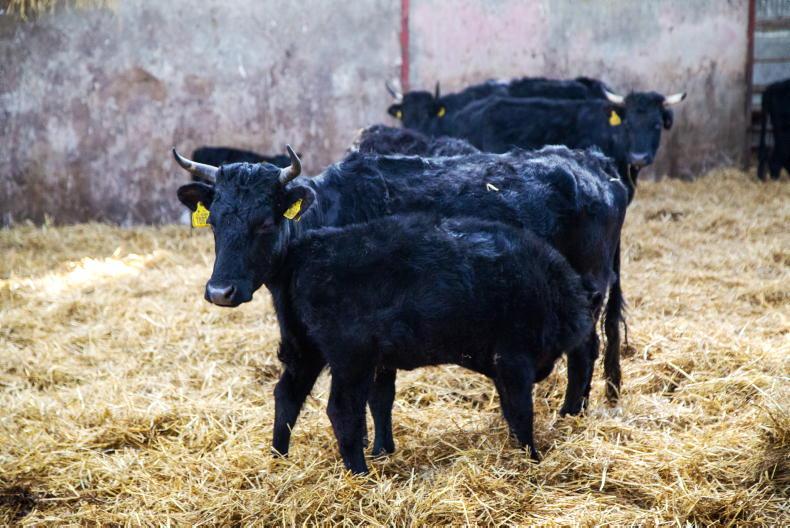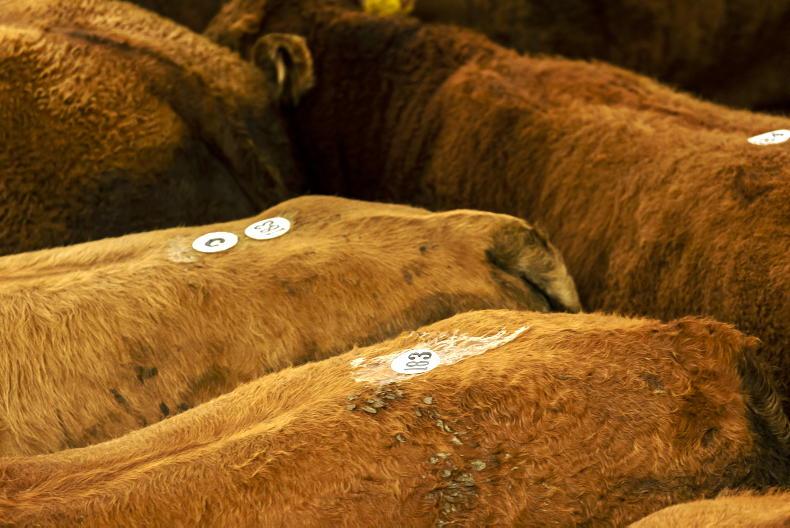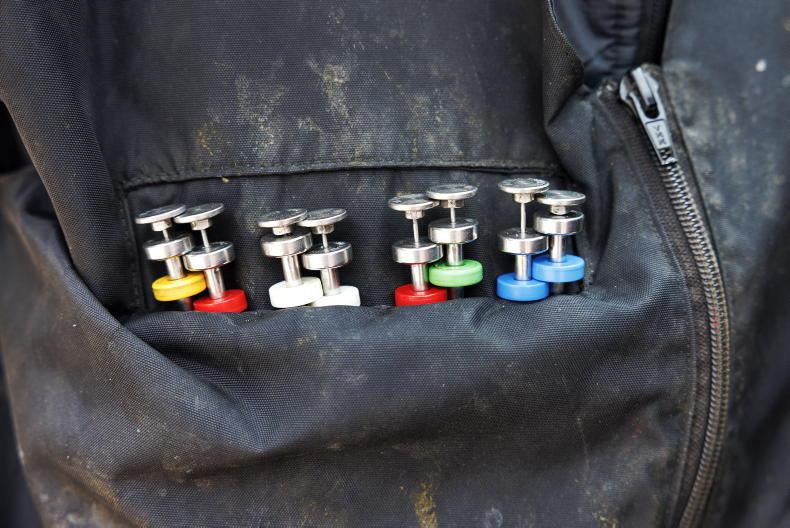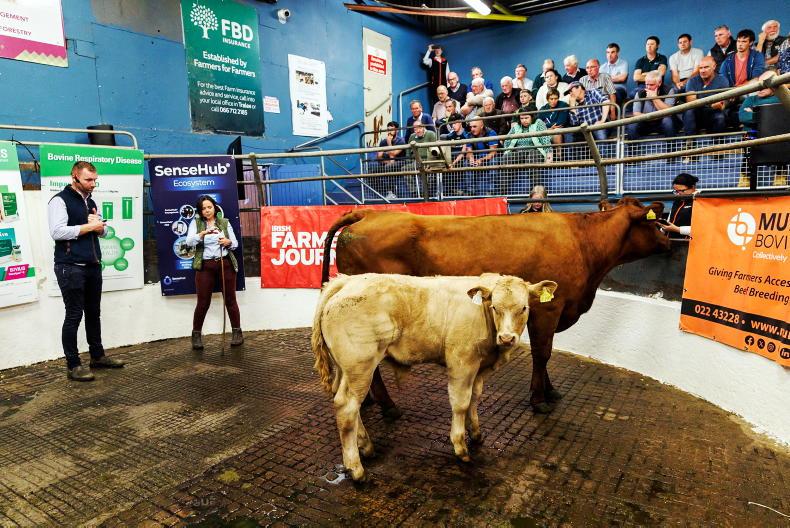The breeding season gets underway during May for suckler herds that started calving in February. Like most aspects of suckler farming, herd management has a direct effect on getting cows back in-calf again. Silage quality was good in 2024 and reports from suckler farms are that cows have calved down in good condition and body condition has been maintained well on early calving cows. A lot of farmers in drier areas have also managed to get cows out earlier than other years which is always a big help when looking to kick start breeding in late spring and early summer.
Conditioning
Having cows in good body condition and grazing high-quality swards are just a couple of factors within the farmer’s control that can increase conception rates ahead of this year’s breeding season. When it comes to preparing for the upcoming breeding season, outlined are five tips to managing cows and stock bulls.
Is the stock bull ready for work?
Early April is the best time to prepare the stock bull for breeding. Most bulls are wintered on a maintenance diet, but now is the time to start building body condition ahead of the breeding season. Feeding 3kg to 4kg/day of a general-purpose ration, along with above-average to good-quality silage (68 to 70 DMD) will improve body condition in a gradual manner.
Exercise is also important. Bulls should be allowed out to a handling pen for a few hours daily. This will improve muscle tone and show up any problems with feet. If feet have become overgrown, they should be trimmed as early as possible and at least four to six weeks before the start of breeding. Check the animal’s testicles and penis for lumps and warts.
If you’re in doubt about a bull’s fertility, a fertility test is the only definitive way to tell whether your bull is fertile or not. It’s not that expensive and €70-€100 should cover the cost. Identifying a problem ahead of the breeding season is invaluable. If you have purchased a new stock bull this spring a good rule of thumb is to let a young bull to the same number of cows as the bulls age in months. So, if a bull is 16 months of age at the time he is going out with cows, he shouldn’t be let with any more than 16 cows in his first year of breeding.
Young bulls can be on a high plain of feeding in the run-up to sales so it’s important to take them back gradually onto a lower plain of nutrition. Big drops on body condition can affect fertility levels and could cause a young bull to be sub fertile for a period of time.
Have cows settled at grass two weeks before breeding starts
As cows transition from silage to grazing fresh grass, the change in diet can have a negative impact on fertility. Therefore, if breeding is due to start in May, it is important to have cows settled at grass at least two weeks before the bull is turned out to start breeding. This gets animals over the transition period in diet and helps with conception rates.
Once at grass, it’s important that there isn’t a period where cows go hungry or grass runs out. Make sure cows are fed to appetite every day and are under no stress due to low grass supplies.

2.
Treat thin cows and
first-calved heifers
as priority animals
First-calved heifers and thinner cows will be under nutritional stress during early lactation. If these animals are not getting adequate energy and protein from the diet, they will lose body condition and be slow to come in heat or hold to service. It is important that these animals are given priority management. This means they should be the first cows to get out to grass, as well as grazing in a separate group during April.
Depending on body condition, grazing these animals as a separate group allows supplementary concentrates to be offered for building body condition. If still housed, depending on silage quality they should be getting 3-4kgs/day of a good quality ration along with good quality silage. Make sure there is adequate feed space as these young cows/heifers can get bullied and are sometimes too shy to feed.
When the condition has improved, thin cows can rejoin the main herd for breeding. In herds with multiple stock bulls, consider keeping these animals as a separate breeding group if possible.

3.
Mineral supplementation
Mineral supplementation is important during the breeding season. Grass can supply a lot of the trace minerals required by cattle, but supplementing with iodine, selenium, copper and phosphorus is always a good idea especially if there have been issues in the past in relation to mineral deficiencies on the farm.
Taking a blood sample from a few cows or taking a forage sample will give you a breakdown of what is needed quite quickly.
There are multiple ways to supplement cows with minerals and they all have merits. It comes down to cost and the practicalities of supplementation. A slow release bolus will give good cover for a few months which will cover breeding.

4.
Keep stress to a
minimum when using AI
While most farmers will opt for natural service at grass, there will be farmers looking to make use of AI to get cows back in calf. When it comes to using AI at grass, keep stress to a minimum. Getting cows familiarised with handling every day will keep animals much more settled at grass.
Rotational grazing and electric fencing are ideal for getting cows used to regular handling.
Cows in heat will be easier to separate for inseminating. Bringing in a small group of cows is much easier than trying to isolate a single cow for breeding. When using AI, graze cows next to the yard, as they are easier to bring in for inseminating. If working part-time it may be practical to feed a small amount of meal in the yard to cows when cows come into the yard to encourage them back in the next time.
Most farmers work to the AM/PM rule and that is if a cow is in heat in the morning, she is inseminated in the evening while a cow in heat in the evening can be inseminated the next morning.

Suckler cows and stock bull.
The breeding season gets underway during May for suckler herds that started calving in February. Like most aspects of suckler farming, herd management has a direct effect on getting cows back in-calf again. Silage quality was good in 2024 and reports from suckler farms are that cows have calved down in good condition and body condition has been maintained well on early calving cows. A lot of farmers in drier areas have also managed to get cows out earlier than other years which is always a big help when looking to kick start breeding in late spring and early summer.
Conditioning
Having cows in good body condition and grazing high-quality swards are just a couple of factors within the farmer’s control that can increase conception rates ahead of this year’s breeding season. When it comes to preparing for the upcoming breeding season, outlined are five tips to managing cows and stock bulls.
Is the stock bull ready for work?
Early April is the best time to prepare the stock bull for breeding. Most bulls are wintered on a maintenance diet, but now is the time to start building body condition ahead of the breeding season. Feeding 3kg to 4kg/day of a general-purpose ration, along with above-average to good-quality silage (68 to 70 DMD) will improve body condition in a gradual manner.
Exercise is also important. Bulls should be allowed out to a handling pen for a few hours daily. This will improve muscle tone and show up any problems with feet. If feet have become overgrown, they should be trimmed as early as possible and at least four to six weeks before the start of breeding. Check the animal’s testicles and penis for lumps and warts.
If you’re in doubt about a bull’s fertility, a fertility test is the only definitive way to tell whether your bull is fertile or not. It’s not that expensive and €70-€100 should cover the cost. Identifying a problem ahead of the breeding season is invaluable. If you have purchased a new stock bull this spring a good rule of thumb is to let a young bull to the same number of cows as the bulls age in months. So, if a bull is 16 months of age at the time he is going out with cows, he shouldn’t be let with any more than 16 cows in his first year of breeding.
Young bulls can be on a high plain of feeding in the run-up to sales so it’s important to take them back gradually onto a lower plain of nutrition. Big drops on body condition can affect fertility levels and could cause a young bull to be sub fertile for a period of time.
Have cows settled at grass two weeks before breeding starts
As cows transition from silage to grazing fresh grass, the change in diet can have a negative impact on fertility. Therefore, if breeding is due to start in May, it is important to have cows settled at grass at least two weeks before the bull is turned out to start breeding. This gets animals over the transition period in diet and helps with conception rates.
Once at grass, it’s important that there isn’t a period where cows go hungry or grass runs out. Make sure cows are fed to appetite every day and are under no stress due to low grass supplies.

2.
Treat thin cows and
first-calved heifers
as priority animals
First-calved heifers and thinner cows will be under nutritional stress during early lactation. If these animals are not getting adequate energy and protein from the diet, they will lose body condition and be slow to come in heat or hold to service. It is important that these animals are given priority management. This means they should be the first cows to get out to grass, as well as grazing in a separate group during April.
Depending on body condition, grazing these animals as a separate group allows supplementary concentrates to be offered for building body condition. If still housed, depending on silage quality they should be getting 3-4kgs/day of a good quality ration along with good quality silage. Make sure there is adequate feed space as these young cows/heifers can get bullied and are sometimes too shy to feed.
When the condition has improved, thin cows can rejoin the main herd for breeding. In herds with multiple stock bulls, consider keeping these animals as a separate breeding group if possible.

3.
Mineral supplementation
Mineral supplementation is important during the breeding season. Grass can supply a lot of the trace minerals required by cattle, but supplementing with iodine, selenium, copper and phosphorus is always a good idea especially if there have been issues in the past in relation to mineral deficiencies on the farm.
Taking a blood sample from a few cows or taking a forage sample will give you a breakdown of what is needed quite quickly.
There are multiple ways to supplement cows with minerals and they all have merits. It comes down to cost and the practicalities of supplementation. A slow release bolus will give good cover for a few months which will cover breeding.

4.
Keep stress to a
minimum when using AI
While most farmers will opt for natural service at grass, there will be farmers looking to make use of AI to get cows back in calf. When it comes to using AI at grass, keep stress to a minimum. Getting cows familiarised with handling every day will keep animals much more settled at grass.
Rotational grazing and electric fencing are ideal for getting cows used to regular handling.
Cows in heat will be easier to separate for inseminating. Bringing in a small group of cows is much easier than trying to isolate a single cow for breeding. When using AI, graze cows next to the yard, as they are easier to bring in for inseminating. If working part-time it may be practical to feed a small amount of meal in the yard to cows when cows come into the yard to encourage them back in the next time.
Most farmers work to the AM/PM rule and that is if a cow is in heat in the morning, she is inseminated in the evening while a cow in heat in the evening can be inseminated the next morning.

Suckler cows and stock bull.














SHARING OPTIONS